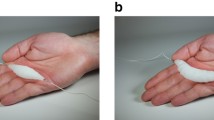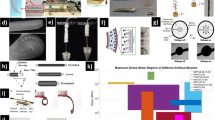Abstract
Soft robotics has gained significant interest due to its resemblance to soft organic bodies, enabling direct human interaction. Soft actuators are a crucial component of these soft robots as they enable their motion. This work introduces a comprehensive investigation and experimental results of a reinforced bidirectional artificial muscles (Rbi-AMs) design. In addition to the well-known bellow actuator, we propose the integration of inner and external rings to enhance performance and enable bidirectional operation by using their pressurization or vacuum. To evaluate the performance of these designs, we connected the reinforced bidirectional pneumatic-driven artificial muscles to a tensile testing machine and compared their pulling and pushing forces. Their deformation was also assessed when subjected to varying payloads under pressurization or vacuum. Results indicate that the design with an inner ring outperforms others, achieving a pushing force of 50 N and a strain of 150.54% at 40 kPa, as well as a pulling force of 24 N and a contraction ratio of 49.90% at −40 kPa. To assess applicability, we conducted a robustness evaluation, with the actuators demonstrating durability and readiness for real-life applications after 250 cycles in both directions. The proposed designs exhibit excellent force, strain, and robustness compared to current research in the field. Furthermore, we present a modular system and gripper demonstration, where the actuators collectively create a multi-DOF robotic joint and a gripper that can adapt its grasping range to accommodate objects of varying shapes, sizes, and weight.







Similar content being viewed by others
References
Wirtz J et al (2018) Brave new world: service robots in the frontline. J Serv Manag 29(5):907–931. https://doi.org/10.1108/JOSM-04-2018-0119
Trivedi D, Rahn CD, Kier WM, Walker ID (2008) Soft robotics: Biological inspiration, state of the art, and future research. Appl Bionics Biomech 5(3):99–117. https://doi.org/10.1080/11762320802557865
Rus D, Tolley MT (2015) Design, fabrication and control of soft robots. Nature 521(7553):467–475. https://doi.org/10.1038/nature14543
Li M, Pal A, Aghakhani A, Pena-Francesch A, Sitti M (2022) Soft actuators for real-world applications. Nat Rev Mater 7(3):235–249. https://doi.org/10.1038/s41578-021-00389-7
Oh N, Lee JG, Rodrigue H (2023) Torsional pneumatic actuator based on pre-twisted pneumatic tubes for soft robotic manipulators. IEEE/ASME Trans Mechatron PP:1–11. https://doi.org/10.1109/TMECH.2023.3262235
Boyraz P, Runge G, Raatz A (2018) An overview of novel actuators for soft robotics. High-Throughput 7(3):1–21. https://doi.org/10.3390/act7030048
Coutinho A, Park JH, Jamil B, Choi HR, Rodrigue H (2023) Hyperbaric vacuum-based artificial muscles for high-performance actuation. Adv Intell Syst 5(1):2200090. https://doi.org/10.1002/aisy.202200090
Lian OC, Keong CK, Nishimura T, Jae-Yeol K (2020) Form-finding of spine inspired biotensegrity model. Appl Sci 10(18):1–19. https://doi.org/10.3390/APP10186344
Coutinho A, Rodrigue H (2023) Fluidic hardware strategies for powering combined negative- and positive-pressure artificial muscles. Adv Eng Mater 2300071:1–9. https://doi.org/10.1002/adem.202300071
Horchler AD et al (2015) Worm-like robotic locomotion with a compliant modular mesh. Lect Notes Comput Sci 9222:26–37. https://doi.org/10.1007/978-3-319-22979-9_3
Katzschmann RK, DelPreto J, MacCurdy R, Rus D (2018) Exploration of underwater life with an acoustically controlled soft robotic fish. Sci Robot 3(16):1–13. https://doi.org/10.1126/SCIROBOTICS.AAR3449
Maccurdy R, Katzschmann R, Kim Y, Rus D (2016) Printable hydraulics: a method for fabricating robots by 3D co-printing solids and liquids. Proc IEEE Int Conf Robot Autom, vol. 2016-June, pp 3878–3885. https://doi.org/10.1109/ICRA.2016.7487576
Hilby K, Padia V, Hunter I (2022) Design and analysis of origami-inspired, large-elongation, reconfigurable soft robot modules. In: 2022 IEEE 5th Int Conf Soft Robot RoboSoft 2022, pp 132–139. https://doi.org/10.1109/RoboSoft54090.2022.9762124
Lee H, Rodrigue H (2023) Harnessing the nonlinear properties of buckling inflatable tubes for complex robotic behaviors. Mater Today 63(March):59–88. https://doi.org/10.1016/j.mattod.2023.02.005
Jamil B, Oh N, Lee JG, Lee H, Rodrigue H (2023) A review and comparison of linear pneumatic artificial muscles. Int J Precis Eng Manuf Green Technol. https://doi.org/10.1007/s40684-023-00531-6
Drotman D, Ishida M, Jadhav S, Tolley MT (2019) Application-driven design of soft, 3-d printed, pneumatic actuators with bellows. IEEE/ASME Trans Mechatron 24(1):78–87. https://doi.org/10.1109/TMECH.2018.2879299
Mosadegh B et al (2014) Pneumatic networks for soft robotics that actuate rapidly. Adv Funct Mater 24(15):2163–2170. https://doi.org/10.1002/adfm.201303288
Polygerinos P, Wang Z, Galloway KC, Wood RJ, Walsh CJ (2015) Soft robotic glove for combined assistance and at-home rehabilitation. Rob Auton Syst 73:135–143. https://doi.org/10.1016/j.robot.2014.08.014
Takashima K, Sugitani K, Morimoto N, Sakaguchi S, Noritsugu T, Mukai T (2014) Pneumatic artificial rubber muscle using shape-memory polymer sheet with embedded electrical heating wire. Smart Mater Struct. https://doi.org/10.1088/0964-1726/23/12/125005
Wang T, Ge L, Gu G (2018) Programmable design of soft pneu-net actuators with oblique chambers can generate coupled bending and twisting motions. Sensors Actuators A Phys 271:131–138. https://doi.org/10.1016/j.sna.2018.01.018
Boxerbaum AS, Shaw KM, Chiel HJ, Quinn RD (2012) Continuous wave peristaltic motion in a robot. Int J Rob Res 31(3):302–318. https://doi.org/10.1177/0278364911432486
Schaffner M, Faber JA, Pianegonda L, Rühs PA, Coulter F, Studart AR (2018) 3D printing of robotic soft actuators with programmable bioinspired architectures. Nat Commun. https://doi.org/10.1038/s41467-018-03216-w
Wang Z et al (2021) A soft robotic hand based on bellows actuators for dishwashing automation. IEEE Robot Autom Lett 6(2):2139–2146. https://doi.org/10.1109/LRA.2021.3061063
Balak R, Mazumdar YC (2020) Multi-modal pneumatic actuator for twisting, extension, and bending. IEEE Int Conf Intell Robot Syst 2020:8673–8679. https://doi.org/10.1109/IROS45743.2020.9341555
Belforte G, Eula G, Ivanov A, Visan AL (2014) Bellows textile muscle. J Text Inst 105(3):356–364. https://doi.org/10.1080/00405000.2013.840414
Dämmer G, Gablenz S, Hildebrandt A, Major Z (2019) PolyJet-printed bellows actuators: design, structural optimization, and experimental investigation. Front Robot AI 6(MAY):1–10. https://doi.org/10.3389/frobt.2019.00034
Galloway KC et al (2016) Soft robotic grippers for biological sampling on deep reefs. Soft Robot 3(1):23–33. https://doi.org/10.1089/soro.2015.0019
Cao M, Sun Y, Zhang J, Ying Z (2023) A novel pneumatic gripper driven by combination of soft fingers and bellows actuator for flexible grasping. Sensors Actuators A Phys. 355:114335. https://doi.org/10.1016/j.sna.2023.114335
Navas E, Fernández R, Armada M, Gonzalez-De-santos P (2021) Diaphragm-type pneumatic-driven soft grippers for precision harvesting. Agronomy. https://doi.org/10.3390/agronomy11091727
Digumarti KM, Conn AT, Rossiter J (2017) Euglenoid-inspired giant shape change for highly deformable soft robots. IEEE Robot Autom Lett 2(4):2302–2307. https://doi.org/10.1109/LRA.2017.2726113
Ma H, Zhou J (2023) Modeling, characterization, and application of soft bellows-type pneumatic actuators for bionic locomotion. Acta Mech Solida Sin 36(1):1–12. https://doi.org/10.1007/s10338-022-00346-z
Udupa G, Sreedharan P, Dinesh PS, Kim D (2014) Asymmetric bellow flexible pneumatic actuator for miniature robotic soft gripper. J Robot. https://doi.org/10.1155/2014/902625
Higueras-Ruiz DR, Shafer MW, Feigenbaum HP (2021) Cavatappi artificial muscles from drawing, twisting, and coiling polymer tubes. Sci Robot. https://doi.org/10.1126/SCIROBOTICS.ABD5383
Joe S, Totaro M, Wang H, Beccai L (2021) Development of the ultralight hybrid pneumatic artificial muscle: modelling and optimization. PLoS ONE 16(4):1–21. https://doi.org/10.1371/journal.pone.0250325
Lee JG, Rodrigue H (2019) Origami-based vacuum pneumatic artificial muscles with large contraction ratios. Soft Robot 6(1):109–117. https://doi.org/10.1089/soro.2018.0063
Jiao Z et al (2022) Lightweight dual-mode soft actuator fabricated from bellows and foam material. Actuators. https://doi.org/10.3390/act11090245
Usevitch NS, Okamura AM, Hawkes EW (2018) APAM: antagonistic pneumatic artificial muscle. Proc IEEE Int Conf Robot Autom, pp 1539–1546. https://doi.org/10.1109/ICRA.2018.8460881
Tanaka J, Ogawa A, Nakamoto H, Sonoura T, Eto H (2020) Suction pad unit using a bellows pneumatic actuator as a support mechanism for an end effector of depalletizing robots. ROBOMECH J. https://doi.org/10.1186/s40648-019-0151-0
Dämmer G, Gablenz S, Hildebrandt A, Major Z (2019) Design of an additively manufacturable multi-material light-weight gripper with integrated bellows actuators. Adv Sci Technol Eng Syst 4(2):23–33. https://doi.org/10.25046/aj040204
Acknowledgements
This work was supported by the National Research Foundation of Korea (NRF) grant funded by the Korea government (Ministry of Science, ICT & Future Planning) (No. RS-2023-00207772 and No. 2021R1A2C4001792).
Author information
Authors and Affiliations
Corresponding author
Ethics declarations
Conflict of interest
The authors declare no conflict of interest.
Additional information
Publisher's Note
Springer Nature remains neutral with regard to jurisdictional claims in published maps and institutional affiliations.
Supplementary Information
Below is the link to the electronic supplementary material.
Supplementary file1 (MP4 21562 KB)
Supplementary file2 (MP4 113838 KB)
Rights and permissions
Springer Nature or its licensor (e.g. a society or other partner) holds exclusive rights to this article under a publishing agreement with the author(s) or other rightsholder(s); author self-archiving of the accepted manuscript version of this article is solely governed by the terms of such publishing agreement and applicable law.
About this article
Cite this article
Coutinho, A., Kim, S. & Rodrigue, H. Reinforced bidirectional artificial muscles: enhancing force and stability for soft robotics. Intel Serv Robotics 17, 55–66 (2024). https://doi.org/10.1007/s11370-023-00487-1
Received:
Accepted:
Published:
Issue Date:
DOI: https://doi.org/10.1007/s11370-023-00487-1




